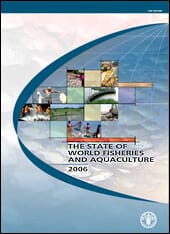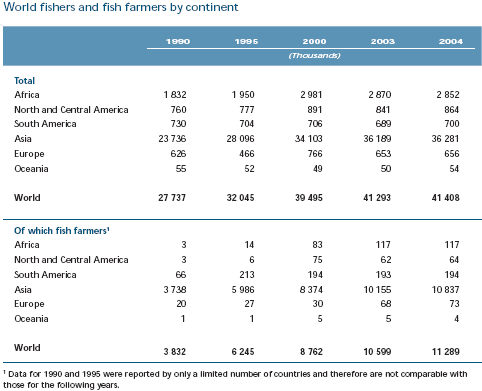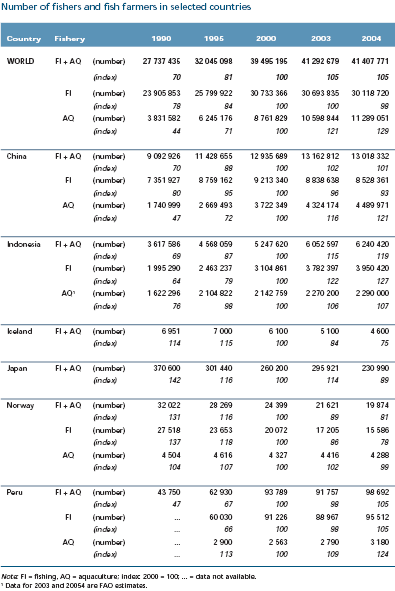 The state of World Fisheries and Aquaculture 2006 The state of World Fisheries and Aquaculture 2006 |
Fishers and Fish Farmers
Millions of people around the world depend on fisheries and aquaculture, directly or indirectly, for their livelihoods. During the past three decades, the number of fishers and aquaculturists has grown faster than the world’s population, and employment in the fisheries sector has grown faster than employment in traditional agriculture. In 2004, an estimated 41 million people (Table 7) worked (part time or full time) as fishers and fish farmers, accounting for 3.1 percent of the 1.36 billion people economically active in agriculture worldwide and representing a growth rate of 35 percent from the corresponding figure of 2.3 percent in 1990. The great majority of fishers and fish farmers are in developing countries, principally in Asia. Significant increases over recent decades, in particular in Asia, reflect the strong expansion of aquaculture activities. In 2004, the number of fish farmers accounted for one-quarter of the total number of fish workers. This figure is indicative, as some countries do not collect employment data separately for the two sectors and some other countries’ national systems do not yet account for fish farming.

China is by far the country with the highest number of fishers and fish farmers, reported to be 13.0 million in 2004 (31 percent of the world total). Of these, 4.5 million were fish farmers (an increase of 158 percent compared with numbers in 1990), while 8.5 million worked in capture fisheries. Current fleet-size reduction programmes in China, aimed at reducing overfishing, are reducing the number of full-time and part-time fishers. The number of people engaged in capture fisheries declined by 13 percent during the period 2001-04 and there are plans to transfer a proportion of fishers to other jobs by 2007. The policy tools to accomplish this move include, among others, scrapping vessels and training redundant fishers in fish farming. In 2004, other countries with a significant number of fishers and fish farmers were India, Indonesia and Viet Nam.
While the number of people employed in fisheries and aquaculture has been growing steadily in most low- and middle-income countries, the numbers in most industrialized economies have been declining or have remained stationary (Table 8). In Japan and Norway the numbers of fishers have more than halved between 1970 and 2004, with a decrease of 58 percent and 54 percent, respectively. In many industrialized countries, the decline has occurred mainly for fishers working in capture fisheries, while the number of fish farmers has increased.
Estimates indicate that there were about 1 million fishers in industrialized countries in 2004, representing a decline of 18 percent compared with 1990 figures. Productivity increases and falling recruitment count among the various reasons for these shrinking numbers.
In recent decades, growing investment in costly onboard equipment, resulting in higher operational efficiencies and less need for seagoing personnel, has led to a significant decline in the number of people employed at sea.
Moreover, the average age of active fishers is increasing as a result of the rapid decline of recruitment into capture fisheries. For example, according to the 2003 Fishery Census of Japan, 47 percent of male fishers were 60 years of age or older in 2004, 23 percent higher than in 1988. At the same time, the share of the younger group of fishers (under 40 years old), which represented one-quarter of the total number of marine fishers in Japan in 1982, had declined to 13.3 percent by 2003. The number of Japanese workers employed in offshore and distant-water fishing declined during the period 1998-2003 by 28 percent to 25 000 people in 2003.

In industrialized countries, younger workers seem reluctant to go to sea on fishing vessels. There are probably several reasons. For many young men, neither the salaries nor the quality of life aboard fishing vessels compares favourably with those of land-based industries. Also, many will be aware of public concerns about the status of stocks and therefore see capture fisheries as having an uncertain future.
As a result, fishing firms in industrialized countries have begun to look elsewhere when recruiting personnel. In Europe, fishers from the economies in transition or from developing countries are starting to replace local fishers. Also in Japan, foreign workers have been allowed to work on Japanese distant-water fishing vessels under the “maruship system”.
A characteristic feature of employment in the fishing industry is the prevalence of occasional or part-time employment, peaking in the months of the year when riverine, coastal and offshore resources are more abundant or available, but leaving time in seasonal lows for other occupations. This is especially true in fisheries for migratory species and those subject to seasonal weather variations. During the past three decades, the number of full-time fishers has declined while the number of parttime fishers has grown quite rapidly. This trend has been particularly marked in Asia.
It is not possible to obtain a comprehensive picture of the role of women in the fisheries sector from the available statistics. Millions of women around the world, particularly in developing countries, work in the sector. Women participate as entrepreneurs and by providing labour before, during and after the catch in both artisanal and commercial fisheries. Their labour often consists of making and mending nets, baskets and pots and baiting hooks. In fishing, women are rarely engaged in commercial offshore and deep-sea waters, but more commonly involved in fishing from small boats and canoes in coastal or inland waters – harvesting bivalves, molluscs and pearls, collecting seaweed and setting nets or traps. Women also play an important role in aquaculture, where they attend to fish ponds, feed and harvest fish, and collect prawn larvae and fish fingerlings. However, women’s most important role in both artisanal and industrial fisheries is at the processing and marketing stages. In some countries, women have become important entrepreneurs in fish processing; in fact, most fish processing is performed by women, either in their own cottage-level industries or as wage labourers in the large-scale processing industry.
The fisheries sector, including aquaculture, is an important source of employment and income. However, employment in fishing and fish farming cannot be taken as the sole indication of the importance of fisheries to a national economy. The fishing industry also generates considerable employment in shipbuilding and shipyard operations; in the fishing gear industry; in the production of technological equipment; in aquaculture feed production; and in processing, packaging and transport. Unfortunately, statistics are not currently available for the total number of individuals providing inputs to fisheries and aquaculture through these activities.
Further Information
To view the previous article by FAO, Aquaculture Production, please click hereTo view further articles from The State of World Fisheries and Aquaculture 2006, please click here
March 2007

